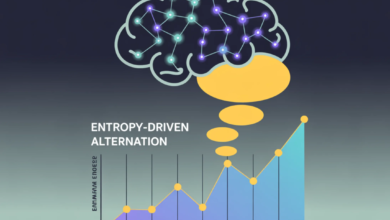Motorola Razr Flip Phones Spotlight AI Innovations

Motorola Razr Flip phones highlight AI innovations
Motorola Razr Flip phones highlight AI innovations When they return to center stage in 2025 with a visionary upgrade. These redesigned devices aren’t just foldable smartphones, they now harness the power of artificial intelligence to transform how users interact with their mobile devices. For anyone looking to stay ahead of the curve in mobile technology, the new Razr Series offers a bold vision of the future. With every click, consumers will discover functionality designed to reflect, learn and adapt. The demand is now about more than just design, it’s about what the phone can actually do for you.
Read also: Artificial intelligence and urban design
The Razr is reborn: classic foldable style meets AI
The Motorola Razr was once the epitome of elegance and innovation when it was introduced to the market in the early 2000s. Fast forward to 2025, and the brand is proving to be more than just nostalgia. Motorola has reintroduced the Razr and Razr Plus, combining premium foldable elegance with smart AI capabilities. It’s no longer just about a retro look; This device is packed with intelligence that learns user behavior and makes personalized suggestions based on context and location.
With Perplexity AI integrated into the system, Motorola phones position themselves as AI-first tools. This means conversations with your phone feel more natural and immediate, going beyond voice commands and into real-time sharing territory. It’s a new level of technological convergence, where hardware and software blend seamlessly for efficiency, convenience and product longevity.
Smarter screens on the outside
The cover screen is no longer just a window for quick viewing. The new Razr Plus includes an upgraded external display that stretches nearly edge-to-edge. This external display now supports multiple tasks, such as launching full applications, voice search with Perplexity AI, and even taking selfies with preview capabilities. The screen is not only space-saving but provides quick interaction with AI suggestions without opening the device.
It learns user habits and starts showing apps or responses that fit your schedule. For example, if you usually check the weather before leaving the house, your Razr will start automatically suggesting weather updates at that time without you being prompted. This awareness makes the phone more than just a tool, but a proactive assistant that you can rely on throughout the day.
Read also: AI-powered grandmother outsmarts scammers in a funny development
MotoAI: Your personal assistant
With the launch of new Razrs, Motorola is introducing… MotoAI Their own digital assistant. Unlike generic voice solutions, MotoAI is designed to work offline and on-device to maintain privacy while providing intelligent responses. This means Razr users can set reminders, ask questions, and streamline their schedule without needing an active internet connection.
MotoAI has features like instant summarization, personalized feedback creation based on voice input, and security-oriented processing that keeps user interactions protected. Whether you’re navigating traffic, booking an appointment, or preparing for a meeting, MotoAI adjusts responses to your immediate context, increasing efficiency and reducing the need for touch and typing interactions.
The innovation runs through the folding hinge
The Razr Series’ structural design maintains its premium edge. Motorola continues to improve its hinge mechanism, improving longevity and introducing pressure-sensitive folding sensors. These sensors allow the phone to adjust the content that appears on the screen depending on the usage pattern, such as when placed on a table or partially folded to use the camera.
This ergonomic design opens up new ways to shoot, multitask and attend video calls. Along with auto-zoom and smart camera capabilities, the use of AI extends to content creation, providing greater value to social media users, professionals, and content creators alike.
Read also: Personal cancer screening using artificial intelligence
Improved camera system with AI support
The photography system also gets an upgrade thanks to AI-powered image processing. From low-light optimization to automatically filtering images based on facial expressions or image composition, the Razr now acts as a reliable camera. Expect features like real-time scene optimization, AI-guided framing prompts, and swipe-activated editing.
Whether you’re using the dual internal lens setup or viewing selfies on the external display, Motorola aims to make taking great shots simpler, even for beginners. Content creators will enjoy better stability, proactive color corrections, and natural filters ideal for professional layouts or instant social sharing.
Enhanced security and performance powered by AI
Leaving behind the traditional PIN password model, Razr’s new lineup includes smart face unlock with improved life detection. AI plays an important role not only in diagnosis but in continuous learning to flag suspicious behavior patterns and suggest actions such as blocking apps or monitoring location.
The Qualcomm Snapdragon chipset included in the Razr series is designed to accelerate artificial intelligence. This means users will get to experience fast learning curves across the device, while reducing reliance on the cloud for suggestions, processing, or recommendations. This provides faster speeds, uninterrupted workflow, and ensures that your device does not slow down as it ages.
Read also: Artificial intelligence enhances the accuracy of breast cancer screening
Price, availability and future plans
The new Razr models, the Razr and Razr Plus, are scheduled to launch in major markets in the summer of 2025. Pricing starts at $699 for the standard Razr and rises depending on storage and carrier preferences. Motorola has confirmed that these phones will get at least three major Android OS updates and consistent patches to improve AI over the next five years.
The company points to ongoing collaboration with Google and Perplexity AI to further develop on-device learning systems, which could eventually eliminate the need for constant back-end processing. As Motorola moves towards developing AI-driven smartphones, we can expect future models to deepen cross-app integration, health tracking, increased productivity, and smarter interaction with home devices.
Why the Razr Flip is a smart choice in 2025
The Motorola Razr lineup combines timeless design with modern innovation. For consumers who prioritize smart functionality, privacy control, compact form factor, and easy-to-use gadgets, these phones offer a compelling alternative in a saturated market for flat panel smartphones.
By integrating artificial intelligence into its core, Motorola has transformed its devices into adaptive machines that evolve with users. Features like MotoAI, smart external displays, AI-powered photography, and foldable mechanics are not gimmicks, they represent well-thought-out solutions that meet today’s technical needs.
A modern smartphone should be more than just a slab of glass. It must be responsive, secure and predictive. The new Razr phones achieve this goal while embracing the visual flair that once made them special. Motorola has indicated that it is thinking far into the future, not only in terms of where smartphones will go, but also in terms of where the user experience should go.
conclusion
Artificial intelligence isn’t a buzzword with Motorola’s latest Razr foldable phone. The inclusion of intelligent software like MotoAI and Perplexity’s conversational tools shows that Motorola is serious about shaping smartphone interaction of the future. As mobile expectations grow, users will look for devices that understand, automate, and secure everyday tasks. The Motorola Razr 2025 series positions itself as a clear leader in this development.
References
Brynjolfsson, Erik, and Andrew McAfee. The Second Machine Age: Work, Progress, and Prosperity in a Time of Great Technologies. W. W. Norton & Company, 2016.
Marcus, Gary, and Ernest Davis. Rebooting AI: Building AI we can trust. Vintage, 2019.
Russell, Stuart. Human consensus: Artificial intelligence and the problem of control. Viking, 2019.
Webb, Amy. The Big Nine: How Tech Giants and Their Thinking Machines Could Distort Humanity. Public Affairs, 2019.
Crevier, Daniel. Artificial Intelligence: The Troubled History of the Search for Artificial Intelligence. Basic Books, 1993.
Don’t miss more hot News like this! Click here to discover the latest in AI news!
2025-06-02 11:09:00




